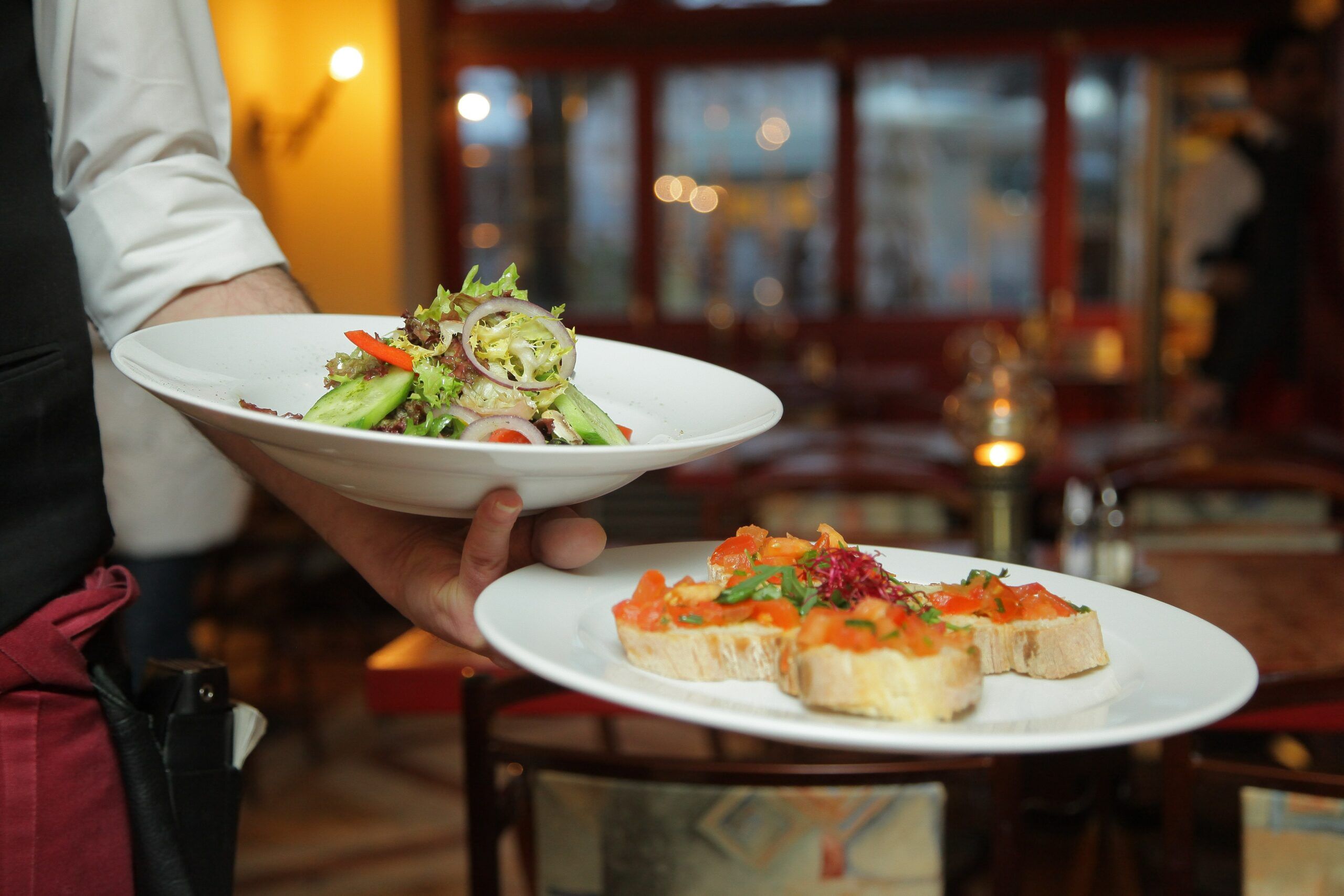- The Latest Restaurant Trends in 2022
- Restaurant Industry Statistics in 2022
- Restaurant Consumer Statistics
The restaurant industry is an incredibly vibrant and ever-evolving space – one where the sky’s the limit for entrepreneurs and professionals who are willing to take a chance and stay ahead of the curve.
Keeping up with changing trends, making sure your business stands out against the competition and improving your service offerings can all bring huge rewards if done right. Plus, there’s the satisfaction that comes from being on the front lines of this always-active industry – it’s an adventure like no other!
However, with such rapid changes, keeping up with the latest foodservice industry trends can be challenging. But don’t worry – we have you covered!
In this article, we have compiled restaurant statistics from the latest studies, articles, and reports to help you understand what’s happening in the restaurant industry and how you can best position your business to stay competitive.
The Latest Restaurant Trends in 2022
Independent restaurants can find that current expectations have changed drastically in the following fields:
- Menu curation
- Supply chain
- Consumer tastes and values
- Food processing and delivery
Here are the top changes that independent restaurant owners should consider:
1. The Rise of Plant-based Cuisine
According to a 2021 “State of the Plate” report by Grubhub, vegan delivery orders increased by 17% compared to 2020. As consumers seek healthier, more sustainable options, plant-based cuisine grows popular.
With meat alternatives like Beyond Meat, Impossible Foods, and Tofurky now readily available, restaurants are shifting their menus to incorporate more vegetarian and vegan options.
2. Fusion Food
According to Datassential report conducted in 2021, one-third of US consumers wanted to try new global foods and/or flavors. And this trend continued in 2022.
Food fusions are a great way to cater to consumers’ desire for unique flavor profiles, utilizing ingredients and cooking techniques from different cuisines.
Some examples include Mexican-Japanese fusion, Middle Eastern-Spanish fusion, and Mediterranean-Indian fusion.
3. Ghost Kitchens
A ghost kitchen is a commercial kitchen to prepare food for delivery or takeout without a dine-in option. These have become increasingly popular in recent years as a way for restaurant operators to save on overhead costs.
With the rise of food delivery apps, they are only expected to grow in popularity.
3. Sustainability and Farm-to-table Dining
Consumers are increasingly interested in knowing where their food comes from and how it is produced.
The term “sustainability” has become increasingly popular in recent years as more and more people are looking for ways to live a more environmentally friendly lifestyle.
A sustainability report by Nielson showed that a whopping 81% of consumers want companies to care about the environment.
Farm-to-table dining is a type of eating that focuses on locally grown and produced foods. This means that food has not had to travel far to get to a consumer’s plate, which is more environmentally friendly.
Moreover, farm-to-table dining often supports local farmers, which is essential for both the economy and the environment.
4. The Rise of Virtual Restaurants
According to an article by The New York Times, virtual restaurants are reshaping the food industry since the pandemic. These restaurants only exist online and do not have a physical location.
Benefits of virtual restaurants include lower overhead costs, greater menu design and pricing flexibility, and the ability to reach a broader audience.
Virtual restaurants rise as more people turn to food delivery apps for convenience.
For an independent restaurant that wants to be successful, staying on top of the latest food trends and consumer habits is essential to stay ahead.
Bonus! Upcoming Restaurant Trends in 2023
Although it is still early to make predictions for 2023, some emerging trends that are expected to be popular include:
3D Printed Meat Are Here To Stay
No one could ever have imagined that something like 3D-printed meat would be a real thing. But it is!
This is an innovative way to create protein-rich meals without the need for animal products or byproducts.
3D-printed meat products are expected to become more popular in 2023 and beyond, as companies such as Redefine Meat have already made great strides in the industry. That’s what’s coming in 2023!
Grain Will Be the Star of the Show in 2023
Grains are becoming increasingly popular as a healthy and sustainable alternative to animal-based proteins.
According to Technomic, grain products with a high-profit margin, including breads and pastas, will shine in 2023.
Restaurants can maximize the versatility of flour by creating dishes like English muffin pizzas, focaccia French toast, fried lasagna, and many other global options like Jamaican coco bread or Sardinian pane carasau flatbread.
With so much creativity in the kitchen available through these ingredients, you’re sure to have amazing new tastes that keep customers coming back!
A rise in Street Foods, Particularly Those from Lebanon
As the street food culture from the Middle East, Asia, and Latin America continues to make its way onto menus in the United States, Technomic anticipates a growth spurt in 2023, with Lebanon leading this new wave.
Shawarma, falafel, hummus, and pitas are only a few of the beloved dishes from this incredible country that diners around the world have come to adore.
But there is much more on offer, too – an array of delightful mezze dips, pickled vegetables, labneh yogurt cheese, kibbeh made with ground meat and bulgur wheat, and man’oushe flatbreads topped off with za’atar spice.
It’s time for everyone to discover these amazing flavors!
Your Inbox, Your Rules!
Tailor your newsletter with the topics you're most interested in.
Restaurant Industry Statistics in 2022
The pandemic and the use of smartphones and food delivery services have resulted in many changes in the restaurant industry.
And with delivery services like Postmates, for instance, getting your food from point A to B has become mush easier!
Trends have changed quickly over the past year, and this has impacted the resulting stats.
So what’s been cooking?
Below you can find the latest restaurant statistics every restaurant business owner should know. These stats cover data related to the following:
- Economy
- Employees
- Consumers
- Social Media
- Sales
- Technology
Restaurant Economy Statistics
- The National Restaurant Association reported a 0.5% in the Restaurant Performance Index in February 2022. The increase was driven by improvements in same-store sales, customer traffic, and capital spending.
The Restaurant Performance Index (RPI) is a monthly composite index that tracks the U.S. restaurant industry’s health and trends. It measures current economic conditions and the outlook for the sector over the next six months. - A BLS report showed that the average household spends about $3,500 on eating out every year.
- According to the 2022 restaurant industry report by the National Restaurant Association, the U.S. foodservice industry workforce is forecasted to grow by 400,000 jobs, for total industry employment of 14.9 million by the end of 2022.
- IBISWorld reported the market size for fast foods was expected to increase by 15.8%.
- The market size for the Global Cloud Kitchen is expected to reach 118.5 billion dollars by 2027.
Restaurant Employee Statistics
- Restaurant operators reported that staffing was their top challenge in 2021. 78% reported being understaffed and not having enough employees to meet customer demands. That’s why it can be handy to have some tips to overcome labor shortages and improve your bottom line.
- 84% of restaurant operators report having higher total labor costs as a percentage of their sales than pre-pandemic levels.
- Nearly 6 in 10 adults have worked in the restaurant industry at some point during their lives.
- The restaurant industry will add 1.6 million jobs over the next decade, with employment reaching 16.9 million by 2029.
Remember that employees are the pillars of your business! And creating a sustainable restaurant work culture is essential if your business wants to overcome major challenges.
Restaurant Consumer Statistics
- 83% of US adults reported not eating on restaurant premises as often as possible.
- Meal Kits usage in the US was expected to rise in 2022 and onwards. According to a recent survey, 61% of 1000 respondents plan to use more meal kits.
A meal kit is a prepackaged set of ingredients that allows consumers to make a specific dish at home. They usually come with easy-to-follow instructions and can be an excellent way for consumers to try new recipes or save time on cooking. - About 67 percent of residents preferred using online delivery services to purchase food during the COVID-19 pandemic in the US.
- 86% of Americans have ordered food delivery at least once a month in 2022.
- According to Deloitte’s 2021 report, 64% of consumers prefer not to dine in.
- 61% of consumers ordered take-out at least once a week in 2021, increasing 32% from the previous year.
- 50% of consumers would consider driverless or drone delivery.
- Based on the 2021 report by NRA, 64% of millennial respondents say that food delivery and takeout are ‘essential to the way they live.’
Restaurant Social Media Statistics
- 72% of customers take a peek at comments on Facebook to make decisions about ordering from restaurants.
- Most restaurant customers leave higher ratings on Facebook than on other social media platforms.
- 99% of Generation Z and Millennial customers are more likely to use social media to determine their restaurant choice than Generation X and Baby Boomers.
- 56% of franchise restaurant owners claim that online reviews increase store traffic more than traditional advertising methods.
- Brands that engage more with customers on social media saw a 40% increase in customer spending.
- Customers find articles, images, and videos the most engaging restaurant content.
- Out of all the social media platforms, Instagram has the highest engagement rate.
Managing your social media is crucial if you want to go move ahead in the game. But what does it take to advance in it?
The best thing you can do is to increase your knowledge in the basics of restaurant marketing and attract more customers!
Restaurant Sales and Payment Statistics
- Average menu prices increased 6.9% between March 2021 and March 2022, representing the most significant 12-month hike since 1981.
- 38% of consumers were more likely to pay with debit cards than credit cards or cash.
- More consumers are using digital wallets and Paypal. Consumer spending on PayPal equaled 8.1. billion dollars.
- Mobile device usage has overtaken laptops and computers. More people are searching for restaurants and ordering food online on their phones.
- Sales from limited-service eating places were 389.48 billion dollars in 2021. It increased by 60 billion from the year before.
Restaurant Technology Statistics
- Most consumers prefer to order digitally for off-premise deliveries.
- Consumers would pay an average of 14 percent more for the chance to use digital ordering methods.
- The presence of free wifi increases the likelihood of customers returning to restaurants.
- Using automated inventory software in the hospitality industry can save up to 100 billion dollars of food waste expenses.
- Utilizing mobile QR code scanners is expected to grow up to 99.5 million users in the US by 2025.
Stay Up-to-date with the Latest Restaurant Industry Statistics and Trends
Given the many changes in the restaurant industry, restaurant owners and operators need to stay up-to-date with the latest trends.
And the best ways to do this include attending industry trade shows and conferences, reading industry publications, searching for the best independent restaurant association, and following relevant thought leaders on social media.
Stay informed of the latest restaurant industry statistics and trends, plus use these as restaurant benchmarks. You can ensure that your restaurant is well-positioned to compete in today’s dynamic market.



